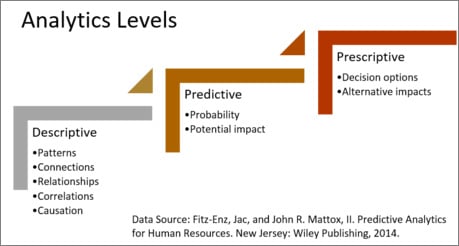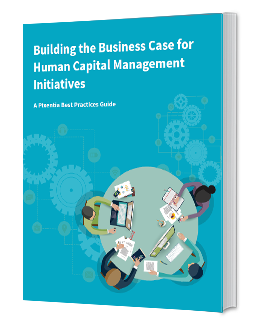
If you read our recent article on HR big data, you know you can analyze your data without advanced analytical tools to discover connections, relationships, correlations, and causations. You may have already started on a test project to affect a business metric by applying your conclusions.
We need analytics to give us insight into the probability of future events and trends. In Predictive Analytics for Human Resources, Jac Fitz-Enz and John Mattox describe three levels of human capital analytics beyond simple reporting.
- Descriptive analytics examines historical data to evaluate connections, relationships, correlations, and causations.
- Predictive analytics uses past patterns to predict future patterns.
- Prescriptive analytics takes prediction to the next level by using complex data to predict alternative outcomes to optimize the workforce.

In a previous article, we described how to use descriptive analytics to develop a test case in which we studied trends and relationships to see how we might affect a business outcome. The time you spent in exploring relationships will guide your thinking in the next step in your path.
The next level in analytics uses predictive analytics to forecast results. The primary tool of predictive analytics is regression analysis.
Regression Analysis
Regression analysis has been with us for two hundred years. In its simplest form, linear regression, it compares two known variables to determine their relationship. In more complex forms, it can compare many variables and even functions with infinite dimensions.
Regression analysis gives us correlations -- how variables are related, and probability -- the likelihood that patterns will repeat. In marketing, we use the techniques to tell us who will be most likely to buy a product (and when, where, and why) so we can target marketing to those consumers.
Many organizations are using regression techniques to determine which candidates for employment will succeed. We find that statistical models are better at hiring decisionsing decisions than manager judgment, and we can create predictive models to tell us which employees are most likely to leave.
Many possibilities come to mind for using analysis of historical trends to predict outcomes. For example:
- Will the impact of role-playing in leadership training justify the cost?
- How will a 10% increase in employee health care costs affect employee retention?
- What will the impact on productivity be if we create a nonmanagerial promotion path for individual contributors?
Assumptions in Data Analysis
What makes predictive analytics work is the underlying assumptions. A false assumption can render a regression model invalid, and the assumptions that were true last year may not be valid today. Assumptions can also be invalid if we don’t include the right variables.
Good data analysts know how to test for the validity of your assumptions, and analytical software has tools for testing them. What is important for business leaders to understand is that invalid assumptions will lead you astray.
Get Started
We recommend a few guidelines to follow to make sure your early efforts are a success.
- Clean your data, but don’t waste resources making it perfect. No one has perfect data. You only need to make good enough to make valid predictions. People data is always messy. Many hands create it, and people make their own judgments about how important accuracy is.
- Make Marketing your new best friend. Marketing has been using predictive analytics for a long time, and they are superb at predicting human behavior. Let them share their experience with you. You might also share assets and expertise.
- Engage an experienced human capital data analyst. You may not need to hire a data analyst. You may be able save money and get better results using an analytics consultant.
- Challenge assumptions. Always be looking for weak assumptions that will skew your results. Question your analysts on their data sources, variables, and assumptions. Ask for explanations of how they deal with outliers in the data.
- Be transparent. Tell your people what information you are collecting and how you are using it. Show them how you don’t measure people – you measure what they do. Explain how you keep their information safe and anonymous. If you don’t have a privacy policy, create one.
- Speak the language of business. Be wary of using “soft” measures like employee engagement. Engagement is not an outcome. Outcomes are profit and productivity. Businesses have spent billions on employee engagement programs over the past few years with little to show. Focus on financial results if you want to be heard.
The Payoff
Using predictive analytics will help you make better decisions and boost your chances of funding your projects. More important, your success will build your credibility with business leaders.
Recommended Reading:
Fitz-Enz, Jac, and John R. Mattox, II. Predictive Analytics for Human Resources. New Jersey: Wiley Publishing, 2014.
Davenport, Tom. "A Predictive Analytics Primer." Harvard Business Review. September 02, 2014.
Pixentia is a full-service technology company dedicated to helping clients solve business problems, improve the capability of their people, and achieve better results.
The problem with using historical trends to make future predictions without statistical analysis is that we cannot test our assumptions nor evaluate the effects of multiple data patterns.


